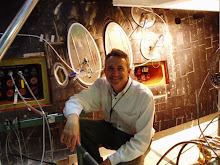 The real MLAS flight vehicle wasn't much more than a fiberglass shell. The MK-70 motor cluster was mounted in a frail-looking "cage" (shown at left with two of four inert motor casings installed) that served only to keep the motors pointed in the right direction. It was mounted inside the Boost Skirt with a series of struts connected to the shell with turnbuckles. Adjustments to the turnbuckles allowed the motors to be aligned with respect to one another and the centerline of the vehicle. They also provided a means for pre-loading the forward end of the cage against the bottom of the CM simulator, so the 280,000 pounds of thrust generated by the motors would be transferred directly to the CM. The CM was itself connected to the Forward Fairing (FF) with four "Y-Fittings" (so-called because of their shape) and held in place with frangible nuts. The Coast and Boost Skirts were connected to one another and the FF with frangible joints. In flight, the motors applied thrust to the base of the CM and propelled it forward; it then carried the Fairing and Skirts along with it. The fins were installed through slots in the Skirt shells and bolted to brackets inside. Aero loads (drag and the lift of the fins) were taken by the shell.
The real MLAS flight vehicle wasn't much more than a fiberglass shell. The MK-70 motor cluster was mounted in a frail-looking "cage" (shown at left with two of four inert motor casings installed) that served only to keep the motors pointed in the right direction. It was mounted inside the Boost Skirt with a series of struts connected to the shell with turnbuckles. Adjustments to the turnbuckles allowed the motors to be aligned with respect to one another and the centerline of the vehicle. They also provided a means for pre-loading the forward end of the cage against the bottom of the CM simulator, so the 280,000 pounds of thrust generated by the motors would be transferred directly to the CM. The CM was itself connected to the Forward Fairing (FF) with four "Y-Fittings" (so-called because of their shape) and held in place with frangible nuts. The Coast and Boost Skirts were connected to one another and the FF with frangible joints. In flight, the motors applied thrust to the base of the CM and propelled it forward; it then carried the Fairing and Skirts along with it. The fins were installed through slots in the Skirt shells and bolted to brackets inside. Aero loads (drag and the lift of the fins) were taken by the shell.The only other significant internal structure was at the top of the Forward Fairing where the turnaround drogue chutes were connected. After the motors burned out and the frangible joints fired to separate the Boost and Coast Skirts, the drogues were deployed to re-orient and stabilize the Fairing so the CM could be released. Chute loads were taken through an eight-sided "Octagon Fitting" and some support members installed just below the nose cap and transferred through the Fairing's motor troughs to the CM Y-Fittings. When the Y-Fitting frangible nuts were fired, the CM dropped free of the Fairing.
 I briefly considered mounting the µMLAS motors in some sort of open structure similar to the MLAS motor cage - emphasis on "briefly." Thrust vector alignment would have been just as critical as it was to MLAS and without benefit of the laser metrology used on the real ship, much less certain. And I doubted I could build anything beefy enough to take motor loads without self-disassembling. So I built µMLAS with traditional centering rings cut from 3/16" and 1/4" plywood. I did the cuts with a DeWalt DW660 cutout tool, then turned the stack of rings on the drill press and sanded them to fit the tube sections. The Coast and Boost Skirts each have two rings - the picture to the right is of the ring stack on the drill press taken before the center holes were finished with a sanding drum.
I briefly considered mounting the µMLAS motors in some sort of open structure similar to the MLAS motor cage - emphasis on "briefly." Thrust vector alignment would have been just as critical as it was to MLAS and without benefit of the laser metrology used on the real ship, much less certain. And I doubted I could build anything beefy enough to take motor loads without self-disassembling. So I built µMLAS with traditional centering rings cut from 3/16" and 1/4" plywood. I did the cuts with a DeWalt DW660 cutout tool, then turned the stack of rings on the drill press and sanded them to fit the tube sections. The Coast and Boost Skirts each have two rings - the picture to the right is of the ring stack on the drill press taken before the center holes were finished with a sanding drum.I've started posting additional pics both of the real MLAS and the model under "Photo Collections." When you're browsing the MLAS shots, keep in mind what we were trying to do: this was a quick-turnaround, low-cost concept demonstrator. You won't see clean rooms, bunny-suited technicians, and precisely machined handling fixtures here - we didn't need them. In many ways, MLAS was just a big model rocket. Emphasis this time on "big."

No comments:
Post a Comment